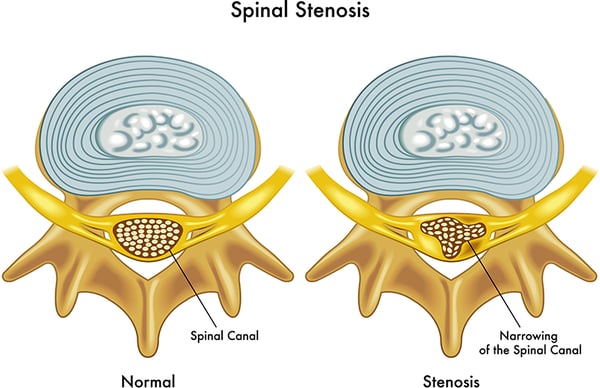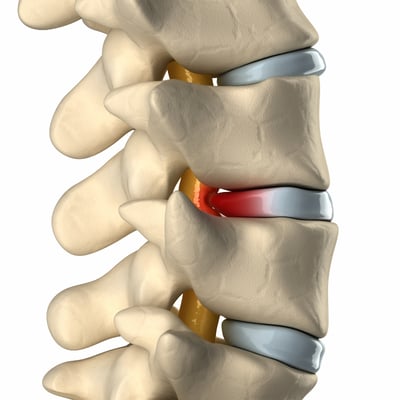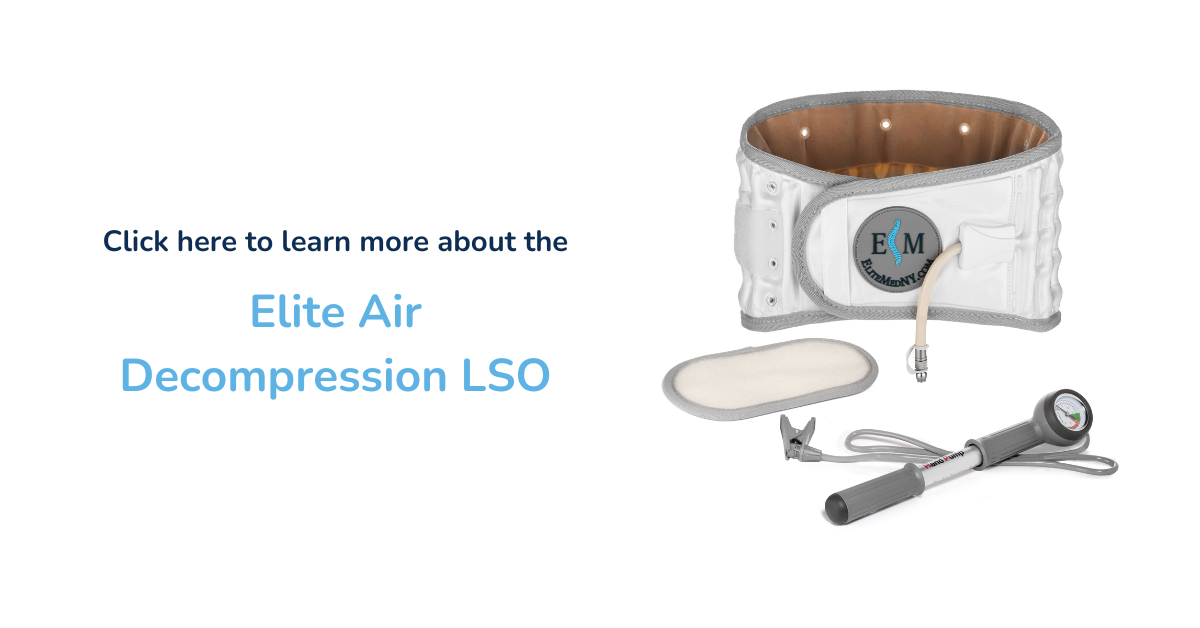Lumbar Spinal Stenosis
Lumbar spinal stenosis is a narrowing of the spinal canal in the lumbar region which results in pressure on the spinal cord or nerves. Spinal stenosis can also occur in the cervical region (neck) but we will focus on stenosis in the lumbar region in this blog. You can learn about cervical and thoracic stenosis in this blog article.
Definition of Stenosis: a narrowing or constricting of a passage in the body.

Causes
Most patients that experience lumbar spinal stenosis are over 50 years of age. This is due to wear and tear on the spine causing inflammation and degeneration from osteoarthritis.
Causes of spinal stenosis:
- Spinal Injury
- Rheumatoid Arthritis
- Tumor
- Spinal canal narrowing (injury, herniated disc)
- Bone Spurs
- Genetic narrow canal (you can be born with a narrow spinal canal)

Image of herniated disc putting pressure on spinal canal
Symptoms
Stenosis of the spinal canal usually occurs gradually over time. At the onset of lumbar spinal stenosis there may be little to no symptoms until narrowing begins to put pressure on the nerves. Pain and symptoms may improve when bending forward or sitting.
Symptoms may include:
- Pain in the lower back
- Radiating pain in the legs (see our Sciatica blog for more details)
- Loss of sensation in the feet
- Numbness or weakness in the legs
In severe cases which require immediate medical attention, lumbar spinal stenosis may result in the following serious symptoms:
- Loss of bowel or bladder control
- Severe or increasing numbness between your legs, inner thighs, and back of the legs
- Severe pain and weakness that spreads into one or both legs. This makes it difficult to walk or get out of a chair.
Diagnosis
Your doctor will evaluate you to determine if symptoms of lumbar spinal stenosis are present. Explain any symptoms you have been experiencing during your visit. This helpful guide provides information to help you effectively communicate at your next healthcare provider visit.
Your doctor may order tests such as x-rays, CT scans, MRI, or myelogram to locate the stenosis cause and determine the severity.
Treatment
A variety of treatment options may be indicated for lumbar spinal stenosis. Healthcare professionals such as physical therapists, specialists, and surgeons could be involved in your treatment plan.
Some treatment options that may be prescribed are:
- Physical therapy
- Stretching & low impact exercise
- Weight management and dietary changes
- Chiropractic care
- Acupuncture
- Non-steroidal, anti-inflammatory medication
- Surgery to correct a physical impediment of the spinal canal
- Lumbar sacral orthosis (LSO) back brace and/or decompression LSO back brace
Surgery is typically a last resort but may be necessary to correct issues such as bone spurs, spinal injury, or a herniated disc. A surgeon will consult with you if your symptoms are serious to determine the best course of action. If you are discussing surgery with your specialist this blog article has some useful information.
We're Here to Help
The team of experts at Elite Medical Supply is here to help identify the right brace for your lumbar spinal stenosis condition. We offer a wide selection of LSO braces, SI (sacroiliac) braces, and a LSO decompression back brace to help alleviate the pain from stenosis. Take a look at our selection of LSO braces by clicking here and selecting the LSO product type.
When you're ready to order a brace or need assistance making a choice we're here to help. You can reach us at 866-712-0881, send us an email, or fill out a contact form.
Written by Elite Medical Supply
Braces and Products Covered by Medicare
Browse ProductsRecent Posts
Topics
- Back Braces (30)
- Knee Braces (30)
- Medicare Beneficiaries (28)
- Pain (23)
- Non-Opioid (20)
- Medical Providers (17)
- Product Highlight (10)
- Sciatica (7)
- Working with your doctor (6)
- Bone Growth Stimulator Therapy (4)
- Bone Growth Stimulators (4)
- Wrist Pain (4)
- Carpal Tunnel Syndrome (3)
- Decompression (3)
- Degenerative disc disease (3)
- Lumbar Spinal Stenosis (3)
- Muscle Spasms (3)
- Neuromuscular Electrical Stimulation (NMES) (3)
- Spinal Stenosis (3)
- Unicompartmental Osteoarthritis (OA) (3)
- Wrist Brace (3)
- wrist tendinitis (3)
- Braces for Golf (2)
- Electrical Stimulation (2)
- Failed Spinal Fusion Syndrome (2)
- Fracture healing (2)
- Kyphosis (2)
- Lower back pain (2)
- Lumbago (2)
- SI Joint (2)
- Total Knee Replacement (2)
- Wrist Braces (2)
- Arthritis (1)
- Braces for skiing (1)
- Bulging or herniated disc (1)
- De Quervain Syndrome (1)
- Digital DME Orders (1)
- Herniated Nucleus Pulposus (1)
- Knee Brace Accessory (1)
- Knee Suspension Wrap (1)
- Knee brace support for skiing (1)
- Muscle Atrophy (1)
- PCL (1)
- SI Joint Dysfunction (1)
- Ulnar Tendinitis (1)
![Elite [spine] Medical Supply logo TRN](https://blog.elitemedicalsupply.com/hubfs/Logo%20Files/Elite%20%5Bspine%5D%20Medical%20Supply%20logo%20TRN.png)
